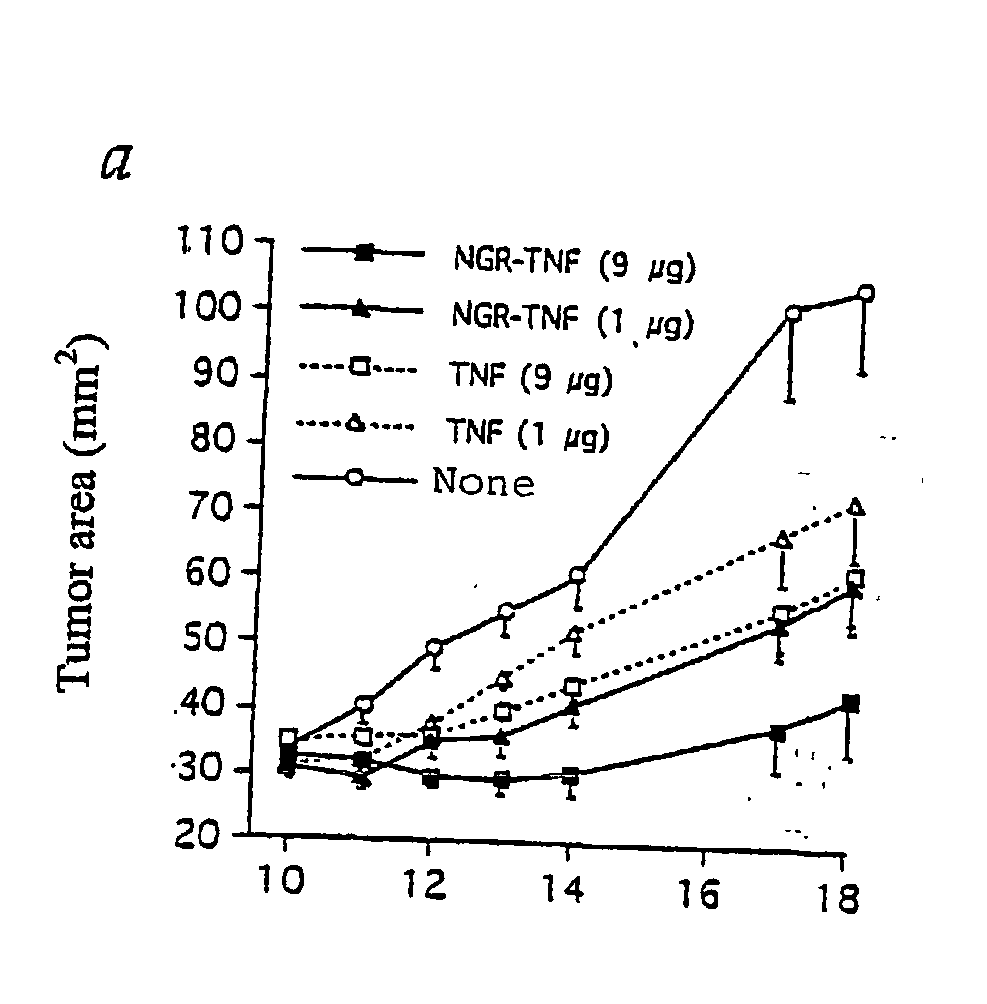Modified cytokines for use in cancer therapy
a technology of cytokines and cancer, which is applied in the field of modified cytokines for use in cancer therapy, can solve the problems of dangerously affecting the human body, strong limitation of the therapeutic use of cytokines, etc., and achieve the effects of improving the biological activity of cytokines, reducing toxicities, and increasing its hydrophobicity
- Summary
- Abstract
- Description
- Claims
- Application Information
AI Technical Summary
Benefits of technology
Problems solved by technology
Method used
Image
Examples
example ii
In vitro Cytotoxic Activity of Murine TNF and NGR-TNF
[0108] The bioactivity of TNF and NGR-TNF was estimated by standard cytolytic assay based on L-M mouse fibroblasts (ATCC CCL1.2) as described (23). The cytolytic activity of TNF and NGR-TNF on RMA-T cells was tested in the presence of 30 ng / ml actinomycin D. Each sample was analyzed in duplicate, at three different dilutions. The results are expressed as mean.+-.SD of two-three independent assays.
[0109] The in vitro cytotoxic activity of TNF and NGR-TNF was (1.2.+-.0.14).times.10.sup.8 units / mg and (1.8.+-.0.7).times.10.sup.8 units / mg, respectively, by standard cytolytic assay with L-M cells. These results indicate that the CNGRCG moieties in the NGR-TNF molecule does not prevent folding, oligomerization and binding to TNF receptors.
[0110] In a previous study we showed that RMA-T cells can be killed by TNF in the presence of 30 ng / ml actinomycin D, whereas in the absence of transcription inhibitors these cells are resistant to TNF...
example iii
Characterization of the Therapeutic and Toxic Activity of Murine TNF and NGR-TNF
[0111] The Rauscher virus-induced RMA lymphoma of C57BL / 6 origin, were maintained in vitro in RPMI 1640, 5% foetal bovine serum (FBS), 100 U / ml penicillin, 100 .mu.g / ml streptomycin, 0.25 .mu.g / ml amphotericin B, 2 mM glutamine and 50 .mu.M 2-mercaptoethanol. RMA-T was derived from the RMA cell line by transfection with a construct encoding the Thy 1.1 allele and cultured as described (14).
[0112] B16F1 melanoma cells were cultured in RPMI 1640, 5% FBS, 100 U / ml penicillin, 100 .mu.g / ml streptomycin, 0.25 .mu.g / ml amphotericin B, 2 mM glutamine, 1% MEM non essential amino acid (BioWhittaker Europe, Verviers, Belgium).
[0113] In vivo studies on animal models were approved by the Ethical Committee of the San Raffaele H Scientific Institute and performed according to the prescribed guidelines. C57BL / 6 (Charles River Laboratories, Calco, Italy) (16-18 g) were challenged with 5.times.10.sup.4 RMA-T or B16F1 liv...
example iv
Mechanism of Action of NGR-TNF
[0122] Anti-mouse CD13 mAb R3-63 purified from ascitic fluids by protein-G Sepharose chromatography (Pharmacia-Upjohn, Uppsala, Sweden), and dialyzed against 0.9% sodium chloride.
[0123] Rabbit polyclonal antiserum was purchased from Primm srl (Milan, Italy) and purified by affinity chromatography on protein-A-Sepharose (Pharmacia-Upjohn). CNGRC and CARAC peptides were prepared as described previously (28).
[0124] To provide evidence that the improved activity of NGR-TNF is dependent on tumor targeting via the NGR moiety we have investigated whether the in vivo activity of NGR-TNF can be partially competed by CNGRC. To this end we have administered NGR-TNF (1 .mu.g) to RMA-T tumor bearing mice, with or without a molar excess of CNGRC. In parallel, other animals were treated with TNF (3 or 9 .mu.g), again with or without CNGRC. As expected, CNGRC decreased significantly the anti-tumor activity of NGR-TNF (FIG. 2a) but not that of TNF (FIG. 2b). At variance...
PUM
| Property | Measurement | Unit |
|---|---|---|
| Fraction | aaaaa | aaaaa |
| Fraction | aaaaa | aaaaa |
| Fraction | aaaaa | aaaaa |
Abstract
Description
Claims
Application Information
 Login to View More
Login to View More - R&D
- Intellectual Property
- Life Sciences
- Materials
- Tech Scout
- Unparalleled Data Quality
- Higher Quality Content
- 60% Fewer Hallucinations
Browse by: Latest US Patents, China's latest patents, Technical Efficacy Thesaurus, Application Domain, Technology Topic, Popular Technical Reports.
© 2025 PatSnap. All rights reserved.Legal|Privacy policy|Modern Slavery Act Transparency Statement|Sitemap|About US| Contact US: help@patsnap.com



